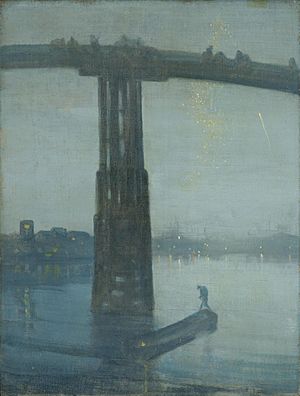Lighterman facts for kids
A lighterman was a skilled worker who operated a lighter. A lighter is a type of flat-bottomed barge, which could be powered by an engine or moved by a tugboat. However, the most famous lightermen were those in the Port of London who used long oars and the river's currents to move their unpowered barges. They were very important for moving goods around the busy River Thames.
Contents
Lightermen in London's Port
A Look Back in Time
Lightermen were a very important group of workers in London's docks. This was especially true when the Port of London was at its busiest. Their job slowly became less common as new shipping technologies developed.
Lightermen worked closely with watermen, who carried passengers on the river. In 1700, they joined forces to create the Company of Watermen and Lightermen. This group helps to license and train watermen and lightermen who work on the River Thames even today. Their historic building, Watermen's Hall, was built in 1780. It is a rare example of a Georgian guild hall that still stands.
When new docks were being built, lightermen were worried about how it would affect their work. However, they won an important rule called the "free-water clause." This rule meant that lighters and barges could enter the docks for free. They could load or unload goods from ships without paying extra fees. This rule helped lightermen keep their jobs. It also meant that goods could be moved directly from ships to riverside warehouses, bypassing the dock's own storage areas.
How They Worked
Before large, enclosed docks were built, lightermen were essential to the Port of London. Big ships would anchor in the middle of the Thames. Lightermen would then use their barges to move goods between these ships and the riverbanks.
They were incredibly skilled at their job. They knew all about the river's currents and tides. They would travel westward when the tide was coming in and eastward when it was going out. This helped them move their unpowered barges up and down the river. They also used long oars, called "paddles," to steer their heavy boats. It was a job that needed a lot of strength and knowledge of the river.
Over time, changes in technology and the growth of container shipping made the lighterman's job less common. Containers are large metal boxes that can be easily moved between ships, trains, and trucks. This new way of moving goods led to the closure of many of London's central docks in the 1960s.
Today, the word "lighterman" is still used for people who operate motorized lighters. These lighters help move goods to and from ships that are too large to dock directly. The phrase "to alight goods" also comes from this trade. It means to unload goods, and it's still used in shipping today.
Lightermen in Hull
The Humber Estuary in Hull also had its own lightermen. This area had strong currents and many shifting sandbanks. For centuries, the Port of Hull relied on lightermen to transfer goods between ships. They were also experts at guiding vessels safely away from dangerous sandbanks.
By the 1800s, enclosed docks were built in Hull. However, it wasn't until steam-powered barges arrived later in the century that the lightermen's special skills became less needed. A specific type of lighterman, called a ballast lighterman, specialized in moving heavy materials like rubble or bricks. These materials were used to balance ships and keep them steady, even in bad weather.
See also
- Company of Watermen and Lightermen
- The Thames Barge Driving Race
- Containerization
- Lightering


